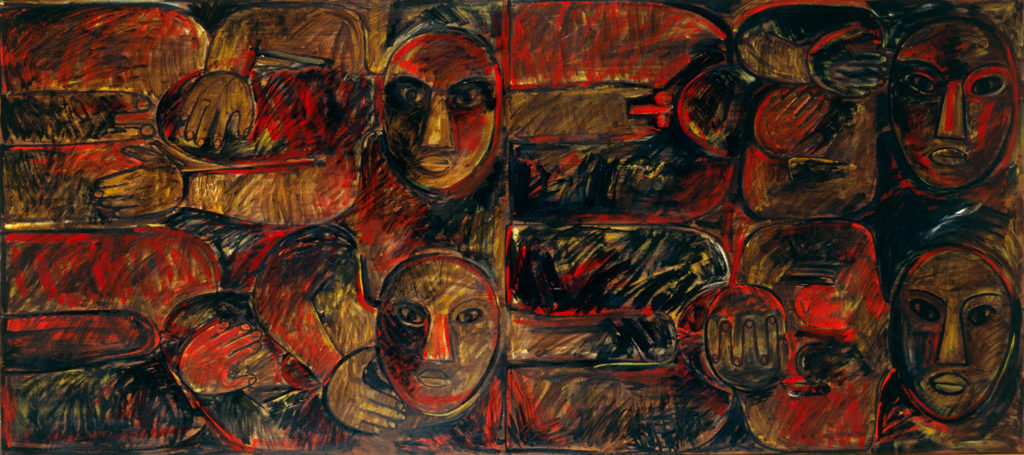ARTISTS Shona Rapira Davies, Robyn Kahukiwa
‘Whakamamae' translates as 'to be made to feel pain'. Wellington artists, Shona Rapira Davies (Ngāpuhi and Ngāti Wai) and Robyn Kahukiwa (Ngāti Porou), present work drawing on their whakapapa (ancestory). Māori culture and protocols are central to the show’s content and display.
Kahukiwa is the Gallery’s first artist-in-residence. Before her six-month stay, she has Haeata—the Māori women’s art collective that organised City Gallery’s 1986 exhibition Karanga Karanga—perform a whakawātea (blessing the space). During her residency, the public can observe her, working in the Gallery.
For the show, walls are added to transform the space to recall a whare whaikaro (meeting house). As on a marae, visitors are asked to remove their shoes before entering. Kahukiwa says the Gallery is ‘sensitive to the Māori side of things and understood our desire that visitors should respect not our work but the ancestors who had been featured’.
Shona Rapira Davies’s twelve life-size terracotta figures, Ngā Mōrehu (The Survivors) greet gallery goers with a silent karanga. Eleven represent Māori women elders, the artist’s tīpuna. They stand and sit on unfinished whāriki harakeke (flax mats). There's writing on their bodies: a waiata (song) that links Ngāti Hine with Te Arawa is painted on the kaikaranga (the woman calling the karanga), while derogatory and obscene statements scar other figures, a reminder of hostile attitudes directed at and borne by Māori women. A twelfth figure, a little girl, stands before them, the inheritor of their ‘her-story’. The words scrawled on her back speak of the future: ‘Did you know you’re much too dark little one? That your eyes aren’t blue. You won’t fit the mould little one kia toa so they’ll try and destroy you little one kia toa, you were born of the survivors little one.’
Ian Wedde in the Evening Post writes, ‘The terracotta women figures by Shona Rapira Davies are more obviously dramatic and rhetorical than Kahukiwa’s complex surfaces. But, in the context of a gallery made over to whare whakairo, and especially given the concern both women feel for the appropriations by well-meaning Pākehā of such rites as the karanga, these life-size figures, whose open mouths are in fact mute, bring home to us the kind of repression, the silencing which this exhibition addresses.’ The work's title refers not only to the survival of the Māori people historically, but also to the sculptures themselves, which survived a studio flood.
Kahukiwa shows nine paintings, titled No Ngā Tipuna (From the Ancestors), and nine drawings alongside traditional taonga, including a female tekoteko. Her expressionist works mark a departure the more illustrative work she is known for, through her Wāhine Toa painting series and book.
A female elder asks Kahukiwa to paint Hinematioro, a Ngāti Porou queen, who lived during Cook’s first visit in 1769. Kahukiwa tells Pacific Way, ‘I'm one of Hinematioro’s descendants, but it was still an honour to be asked. I would never have decided to paint her on my own.’ Kahukiwa also sees seven pilot whales in the Whangara harbour and interprets this as a sign to paint the story of Paikea, an ancestor who came to New Zealand on the back of a whale.
Kahukiwa also completes her largest work to date, the nine panel He Tātai Whetū ki te Rangi Mau Tonu, he Tātai Tangata ki te Whenua Ngaro Noa Ngaro Noa (Gods Never Die, Only People). ‘People get upset by it because I am affirming the existence of Māori Gods. I’m saying they are alive and well and are as relevant today as they were hundreds of years ago’.
Director John Leuthart tells Capital Times, ‘The name bestowed on the exhibition Whakamamae means that the works on display will be powerful statements not only about New Zealand art but also about the historical and social processes which have faced and are facing the Māori people.’ Two kuia—including 'Aunty Bessie', Haeata member Irihapeti Ramsden—give guided tours of the show. Barry Barclay’s 1974 Tāngata Whenua TV documentaries are included in the film programme. Author Janet Potiki writes a personal letter to the artists. ‘Thank you both. You are artists of and for the Tāngata Whenua. You uphold our mana as Māori and as women. We are already in a new time.’ The show attracts a record-breaking 17,000 visitors.
Rapira Davies’s Ngā Morehu is subsequently acquired by the National Art Gallery (now Te Papa Tongarewa Museum of New Zealand, Wellington), and included in the show Headlands: Thinking through New Zealand Art at the Museum of Contemporary Art, Sydney, in 1992. Kahukiwa’s He Tātai Whetū ki te Rangi Mau Tonu, he Tātai Tangata ki te Whenua Ngaro Noa Ngaro Noa is bought by Wellington City Council.






























































































